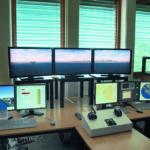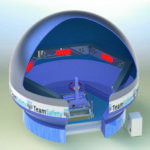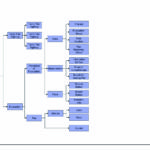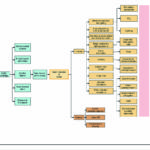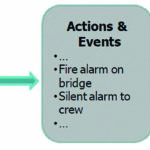Simulator training is an option to meet non-technical requirements of STCW 2010
as it is an accepted method to show not only technical skills but also increasingly
requested social competence. By Birgit Nolte-Schuster and Michael Baldauf
The competence of seafarers and their skills is a crucial factor with regard to safe and secure ship operation in[ds_preview] general, and especially in emergency situations onboard. The Manila Amendments of the International Convention on Standards of Training, Certification and Watchkeeping (STCW) [1, 2], which entered into force on 1 January 2012, reflect this primary concern in substantial and wide-ranging new requirements.
In particular, the Manila Amendments of STCW take into account different technical developments and, therefore, focus on the necessary competencies of the seafarers. In this context, various changes concerning the STCW competence tables can be stated, e. g. for deck officers the need to use an electronic chart display and information system (ECDIS) as mandatory competence standard. In addition to upgrading these technical skills, the STCW also now requires evaluated competencies in the field of non-technical skills. Leadership, teamwork and bridge resource management and related to this decision-making, managerial skills, communication style and cultural awareness are mentioned as essential for operational and management levels onboard.
In its competence tables, the STCW lists approved simulator training as a method for demonstrating the required competence. Among others, Benedict et al. [3] have explained that simulators are well recognized as beneficial especially for ship handling training but also in real time on well- equipped bridges. With new approaches to simulator training, this statement can also be extended to further fields of maritime training, such as team training and maritime safety related subjects.
Apart from existing regulations, such as SOLAS, STCW, ISM, and ISPS, it is essential to adopt a permanent process of change and development and with regard to new precautionary measures to ensure the safety of ship operation and to be prepared in case a hazard occurs on board. Training of human mentality and motivation is vital to create a permanent underlying safety culture.
In the research work at the »TeamSafety« project [4, 5] and within the Maritime Risk and System Safety (MaRiSa) research group at the World Maritime University (WMU) in Malmö (Sweden) inter alia the development, implementation and integration of simulation-based modules into training units and course schemes have been worked out. In its new simulation laboratory, WMU has got a combined ship handling and safety and security simulator, where enhanced test facilities are available, including the 3D visualization of ship spaces.
This simulator, certified by Det Norske Veritas (DNV), can be used as a procedure trainer and enables officers and crew to move around inside the vessel and to use safety equipment and available emergency systems onboard which can be activated by interactive consoles on the bridge or engine control room. In general the effects of safety and security plans and planned procedures onboard can be tested in a simulation environment and enable more detailed evaluation of their effectiveness under varying conditions and during different courses of events within a number of series of simulation runs.
Development of simulation training scenarios
Even today, the most common method in use for the development of simulation exercises is event-driven. Scenarios of real accidents or near-misses (mostly experienced by the instructor) are implemented in order to discuss which mistakes were made or what went wrong as well as how the reconstructed scenarios could be used for instructing trainees to avoid similar failures in the future. In the same way that engineering is often driven by the identification of a specific omission or failure, leading to the development of a new technical device or sophisticated safety system, it is expected that accidents of such type and their underlying human errors will not be repeated. However, despite new technical systems, despite new rules and regulations and despite more and more realistic simulation systems, accidents, unfortunately, still occur. With this in mind it can be assumed that the approach of event-driven design of training scenarios is not yet effective enough [6].
Therefore, it seems to be more appropriate to focus on learning objective-oriented simulation as a tool for maritime education and training. In view of the increasing number of sophisticated simulators including a variety of facilities and technical options it can be assumed that this also means a wider range of options for learning effectiveness. In light of this, it seems useful, first to have a look at the process of knowledge accumulation in general and to sum up the main aspects of the educational scientific substructure, in order to identify the educational potential of simulation platform design and its control functionalities.
With regard to learning theories, it seems appropriate to review the relevant aspects of cognitivism as the preferred underlying methodology. The way of gaining knowledge, the way how to learn and, on the other hand, the reason for learning restriction, especially in stressful situations, is considered by the theoretical assumptions of the »Three Memory« model, which was first developed by Atkinson & Shiffrin in 1968 [7].
In the current context, it has been further expanded through the »Cognitive Load« theory to include the concept of e-learning. The »Three Memory« model focuses on three phases of memory which might be identified as the most important in the process of gaining and accumulating information: sensory memory, short-term memory and working memory, as well as long-term memory. Within the context of a simulation-based virtual training platform and its approach to optimize reaction and communication in critical situations, it is useful to consider the learning process within these memory parts in general and, with regard to human error, to have a closer look at its restrictions.
Briefly described, one of the reasons why information is not kept in mind and inadequate problem-solving might occur is the lack of sufficient, depth and detailed processing of information. The fact that learning objectives do not reach the working memory – e. g. in the absence of motivation or logical progression of ideas, in case where novices have to deal with overly complicated learning objectives – leads to their inability to remember.
As a consequence it can be stated that the complexity level of the simulation scenario has to be well chosen to the expertise level of the trainee. One of the main aspects, which are responsible for an ineffective recall of information, is stress. In this specific situation, stress hormones are discharged and are responsible e. g. for a partial blockage of the synapses. As a matter of fact, in this moment much of the information and especially expertise is unavailable to the trainee. In this regard, it is one of the dedicated options of a simulation scenario that it offers the option to adjust (raise or lower) the stress level during the different sessions by a specific scenario content. So the trainee can learn to cope with stressful situations, such as emergencies, without restrictions in the learning situation itself.
Another reason why we are forgetful lies in the so called »interference« of the learning objectives. In this case, the given information is too similar to existing knowledge and, therefore, it might become mixed up with different meaning during processing. This mixture may also be the reason that this information is not completely or sufficiently integrated in useful and sensitive connected meaning systems. This has to be taken into account and the simulation exercise session shall be structured by clearly defined tasks with step by step and reasonable increase in the level of difficulty.
One of the theoretical assumptions refers to the question of how information is transferred to memory. By explanation and verbalization, especially by direct feedback, these structures are activated in a stimulating process and new information can be linked to already existing experience. In order to support this complicated process it can be helpful to recapitulate the already existing knowledge and mental models.
This can be done during the debriefing process of the simulation session. Besides and with a view to the working memory, where these procedures take place, it can be stated that the working memory has only limited capacity. Consequently, the learning approach should consider the basic idea of »less is more«, which means that only a specific quantity of information should be worked on in the simulation session.
Further it is recommended to have a look at a clear and concrete description of the learning objective as well as additional explanations to support the trainee in the process of »creating mental images«. Especially this process can be well initiated by 3D-simulation when the information is anchored by real action in a simulation-based training environment. This is evident for abstraction and formal logical memory patterns and further ensures that the objectives become an internalized knowledge quality and are not learned only »mechanically«.
Real emergency situation and simulation-based training
Within the »TeamSafety« project, a reference scenario for the emergency situation »Fire onboard a RoRo pax ferry« has been drafted [9, 10]. It can be stated for this specific situation that the coordinated actions of a team as well as personal competencies such as decision-making and leadership are essential for successful problem solving. In particular the aspect of intercultural communication, basically the language competence, is a crucial factor in multicultural crews and plays an important role in the accurate and immediate response by emergency procedures.
For the detailed development and implementation of the sample scenario, information related to real accidents from casualty reports, ISM-compliant company related procedures [11] as well as results of field studies and participation in fire fighting drills have been reviewed and analysed and basic event charts have been drafted. With regard to the aforementioned learning objectives, a set of decision points was specifically integrated for the further development of the simulation scenario (Fig. 4).
The exemplarily shown decisions in Fig. 5, which have to be made at this advanced point of the sequence of events and actions, are foremost linked to fire fighting tactics. The main aspect of this section therefore refers to gaining information about the various parts of the ship involved (cargo information, weather condition, ships plan) and overall the process of communication and teamwork-related aspects of organizing efficient fire fighting.
The leading questions in this learning unit, which have to be worked out in the briefing/debriefing unit, should be put with regard to company specific rules and regulations of the ISM Code implemented in the company and other international regulations, such as SOLAS, as relevant for the training scenario and the individual situation awareness of the trainee.
Based on the decisions made in this section and especially the decision as to whether there is a need for evacuating or abandoning the ship, the scenario should be followed up with the specific steps linked to those tactics, which are chosen as an alternative for action. In principle, the working steps of the methodology can be applied to every individual scenario in which a shipping company wishes to be trained.
It cannot be denied that this methodology implicates the challenge that every course of action generates an adjusted response and in this regard a different continuance of the sketched scenario. This fact entails the difficulty of how to measure the appropriateness and effectiveness of the chosen course of action. In order to avoid this immanent problem it might be helpful to create a model answer and a kind of standard reply pattern for the different scenario options.
When considering the various aspects of the cognitive model it has become obvious that the learning process is both a bottom-up and top-down process of accumulating information. A simulation-based training might take into account this specific complexity by giving feedback (e.g. face to face by the instructor) at the relevant steps of the session. Then, during the debriefing the option of replay of the specific scenario sequences allows a more focussed work on the specific aspects of the scenario here.
Conclusions
The Manila Amendments of the STCW Convention and Code require a bundle of technical and non-technical skills. With regard to these challenges, the state-of-the-art simulation technologies offer a wide range of supporting facilities to meet the related needs of maritime education and training. Nevertheless the provision of high-performance graphic visualization and sophisticated process models by state of the art simulators should not conceal the fact that the scientific verification of its learning effectiveness is still pending (see also [6]).
In its research work, the World Maritime University develops a learning concept which combines in a novel approach the technical- technological options of modern simulation and the methodological needs for internalized learning. By working on a reference scenario »Fire onboard a RoRo pax ferry« which in its final state leads to an evacuation situation and its specific challenges for communication, leadership and decision-making, the functional requirements and prerequisites, e. g. an appropriate group size of the trainees, have been identified and the basic systematology for learning objective related simulation could be laid. Besides these first optimistic results it has become obvious that the work on the evaluation of the efficiency in training and its influence on behavior and performance has to be continued.
The materials and results of the studies have been obtained partly in the research project »TeamSafety« at the World Maritime University, performed under the 7th Framework Programme of the European Union.
Authors:
Dr. Birgit Nolte-Schuster, bns@wmu.se
Dr.-Ing. Michael Baldauf, mbf@wmu.se
World Maritime University, Malmö, Sweden
Dr. Birgit Nolte-Schuster, Dr.-Ing. Michael Baldauf






